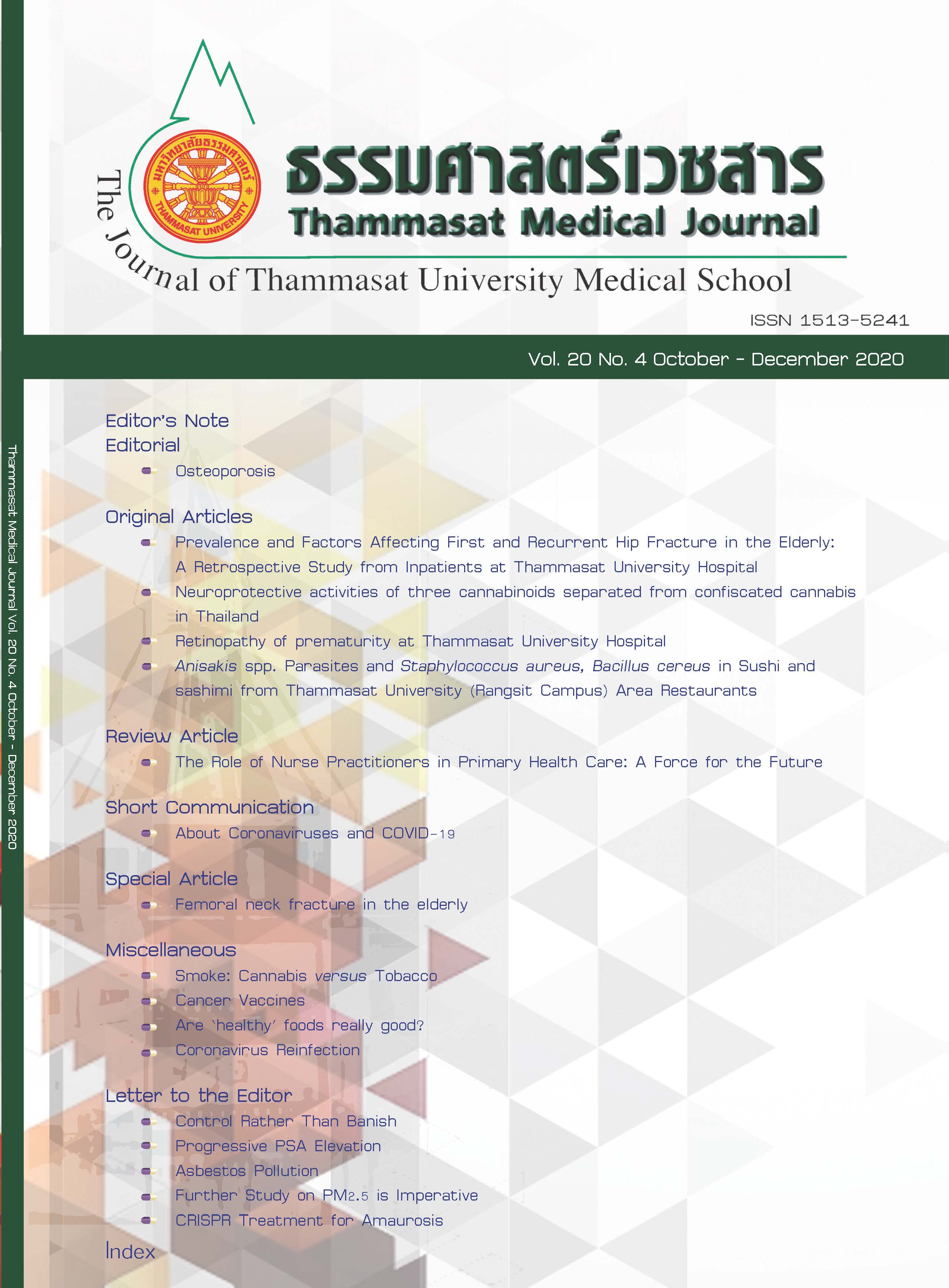Anisakis spp. Parasites and Staphylococcus aureus, Bacillus cereus in Sushi and sashimi from Thammasat University (Rangsit Campus) Area Restaurants
Keywords:
Anisakis spp., Staphylococcus aureus, Bacillus cereus, Sushi, SashimiAbstract
Introduction: Consuming sushi and sashimi is very popular in the Thai society as they can be easily bought in general. The prices may will vary depending on the locations. Sushi and sashimi were a
diet that does not pass heat. There is a unique method in the process of preparing raw fish and molding rice. In addition, the production process requires the use of hands for cooking, which may cause parasitic contamination and pathogenic microbes in food that are harmful to consumers.
Objective: To determine the contamination of helminth Anisakis spp. and bacterial contamination S. aureus, B. cereus in ready-to-eat food samples, sushi and sashimi.
Methods: Total sample 160 sample in total, comprising 125 sushi and 35 sashimi samples, were randomly sampled from the Janpanes restaurants Thammasat University. Using the histological
characteristics of helminth Anisakis spp. through microscopic was performed using Baird-Parker Egg Yolk Tellulite Agar (BPEY) and Mannital egg Yolk phenol red Polymyxin Agar (MYPA) which are selective media.
Results: The sample analyzed from 17 of the approximately restaurants sushi. The restaurants were sampled up to three times over a 3-month period. The results showed no contamination of the Anisakis spp. Contamination of S.aureus 75/160 (46.88%) specimens found in sushi 69/125 (55.20%) samples and sashimi 12/35 (34.29%) samples of B.cereus there were 6/160 (3.75%).
Conclusion: This research shows that ready-to-eat foods such as sushi and sashimi are contaminated with microbes that exceed the standards. This indicates that these food can be a super spread source of the disease.
References
2. Suzuki J, Murata R, Sadamasu K, et al. [The cases of anisakiasis in Tokyo and the detection rates of Anisakis larvae in the processed foods of mackerel]. Jpn J Clin Parasitol. 2011;22:82-84.
3. CFS, Centre for Food Safety. (1999). Sushi and Sashimi. Hong Kong e An evaluation of sushi and sashimi microbiological surveillance 1997e1999. Retrieved from Centrefor food Safetye The Government of the Hong Kong Special Administrative Region website http://www.cfs.gov.hk/english/programme/programme_rafs/programme_rafs_fm_01_09_sshk.html. Accessed Jan 9. 2020.
4. NSW, Food Authority. (2008). Report on food handling practices and microbiological quality of sushi in Australia. Retrieved 21-01-2014, from http://www.foodstandards.gov.au/publications/Pages/reportonfoodhandling4154.aspx. Accessed Jan 9. 2020.
5. Adams, A. M., J. L. Beeh and M. M. Wekell. Health risks of salmon sushi. Lancet. 1990;336:1328.
6. Setyobudi, E., Rohmah, I., Fauziana Syarifah, R., Ramatia, L., Murwantoko, M., & Wahyu Kartika Sari, D. Presence of Anisakis nematode larvae in Indian mackerel (Rastrelliger spp.) along the Indian Ocean southern coast of East Java, Indonesia. Biodiversitas Journal of Biological Diversity. 2019;20(1):313-319.
7. Oshima, T. Anisakiasis - is the sushi bar guilty? Parasitol. Today 1987;3:44-48.
8. Fang, T. J., Wei, Q. K., Liao, C. W., Hung, M. J., & Wang, T. H. Microbiological quality of 8 ํC ready-to-eat food products sold in Taiwan. International Journal of Food Microbiology. 2003;80:241-250.
9. Chen, Y. H., Jackson, K. M., Chea, F. P., & Schaffner, D. W. Quantification and variability analysis of bacterial cross-contamination rates in common food service tasks. Journal of Food Protection. 2001;64:72-80.
10. Bonnell, A. D. Quality Assurance in Seafood Processing. New York: Chapman Hall. 1994.
11. Yang, S. E., Yu, R. C., & Chou, C. C. Influence of holding temperature on the growth and survival of Salmonella spp. And Staphylococcus aureus and the production of Staphylococcal enterotoxin in egg product. International Journal of Food Microbiology. 2001; 63:99-107.
12. Bremer, P. J., Fletcher, G. C., & Osborne, C. (2004). Staphylococcus aureus. Retrieved August 10, 2008, from: http://www.crop.cri.nz/home/research/marine/pathogens/staphylococcus.pdf
13. Rhodenamel, E.J., Harmon, S.M., Baley, N., Shah, D.B., & Bennett, R.W. (1998). Bacteriological Analytical Manual online. Retrieve January 25, 2009, From http://www.cfsan.fda.gov/~ebam/bam-toc.html. Accessed Jan 9. 2020.
14. Ultee, A. & Smid, E. J. Influence of carvacrol on growth and toxin production by Bacillus cereus. International Journal of Food Microbiology. 2001;64:373-378.
15. Valero, M., Fernandez, P. S., & Salmeron, M. C. Influence of pH and temperature on growth of Bacillus cereus in vegetable substrates, Alicante. Food Microbiology. 2003;82:71-79.
16. Martinez, S., Borrajo, R., Franco, I., & Carballo, J. Effect of environment parameter on growth Kinetics of Bacillus cereus (ATCC 7004) after mild heat treatment, Ourense. Food Microbiology. 2007;117:223-227.


